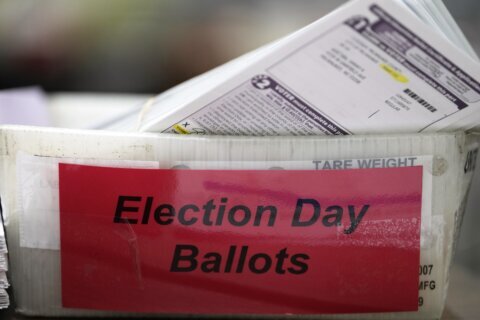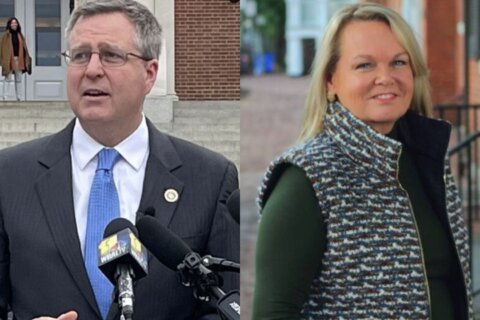Maryland’s U.S. Senate race is already the costliest political battle in the state’s history — and that’s just in the Democratic primary.
Rep. David Trone and Prince George’s County Executive Angela Alsobrooks are vying for the Democratic nomination to succeed longtime U.S. Sen. Ben Cardin.
Normally, the May 14 primary winner would be on a glide path to the U.S. Senate in a blue state where registered Democrats outnumber Republicans 2-to-1.
But these are not normal political times.
The victor of the Democratic primary is expected to face popular former Republican Gov. Larry Hogan, a formidable fundraiser who was elected to two terms in Annapolis.
In addition to what is shaping up as the most competitive U.S. Senate race in Maryland in decades, the contest has national implications for Washington Republicans seeking to regain control of the upper chamber.
“The stakes are very high because the Democrats have a tiny majority in the Senate,” said David Karol, associate professor at the University of Maryland’s department of Government and Politics.
“It’s going to be very difficult for them to retain the majority as it is, and if they were to lose this seat in Maryland, I don’t see how they could conceivably retain the majority. So, there’s a lot at stake here for national politics in a way that’s very unusual for a Maryland Senate race.”
Unprecedented campaign spending
Trone has now spent well over $50 million of his own money on his U.S. Senate campaign.
No candidate in Maryland has ever spent anything close to that kind of money on a political seat — not even close. In the 2016 Democratic Senate primary between now-U.S. Sen. Chris Van Hollen and former congresswoman Donna Edwards, the total was closer to $15 million.
Alsobrooks has criticized Trone for spending so much money, but the congressman has made no apologies for dipping into his personal fortune.
Trone, the founder of Total Wine & More, said he’s willing to spend whatever it takes — not just to beat Alsobrooks, but because he believes he’s the only one with the resources to defeat Hogan in the general election.
Campaign funding is the largest difference between the two candidates. Alsobrooks has raised just under $8 million for her campaign — a significant amount — but only a fraction of Trone’s war chest.
On the issues, there is little daylight between the two, with each staking out similar Democratic positions on a host of issues.
Were Democrats blindsided?
While Trone would have spent a lot of money on his campaign regardless, the late entry of Hogan into the race has clearly changed the dynamic on the Democratic side.
Karol said when Trone and Alsobrooks got into the race, they didn’t expect to face “a serious Republican opponent.” As he pointed out, Maryland has not elected a Republican Senator in more than 40 years — since U.S. Sen. Charles Mathias was reelected in 1980.
“I think they were blindsided by this,” Karol said. “And now electability does become an important concern, especially when you take into account the fact that there is not a big divide on the issues between Mr. Trone and Ms. Alsobrooks.”
Hogan had been on the record saying he had no interest in getting elected to the Senate before he decided to jump into the race in February.
Given Hogan’s formidable political chops, Democrats have been reconsidering their primary.
Karol said it is reasonable for many Democratic voters to ask themselves, “OK, well, which one of them can guarantee victory?”
GOP’s high hopes for Hogan
It’s no secret that the Senate’s top Republican, Mitch McConnell, thought some of the GOP Senate candidates in 2022 were lackluster.
But Republicans have a favorable map for regaining control of the Senate this fall and getting Hogan to run in Maryland was a big political coup for U.S. Sen. Steve Daines (R-Mont.), head of the National Republican Senatorial Committee.
Daines is the GOP point man for getting Republicans elected to the Senate.
“I think it’s a huge windfall for Republicans,” Karol said of Hogan’s candidacy.
Karol points out that with U.S. Sen. Joe Manchin not seeking reelection in West Virginia, Democrats have effectively lost his Democratic seat in a state that’s very red.
So Republicans could regain control of the Senate by picking up just that seat if former President Donald Trump is reelected since they would have a 50-50 tie.
Even if President Joe Biden is reelected, Republicans only need to pick up an additional seat, to get to 51-49. And Democratic incumbents face tough Senate races in Montana and Ohio, among other states.
“So Democrats were in trouble and facing a big challenge to hold the Senate before they got the news that the Maryland race was going to be one that they had to really fight to hold the seat — and they didn’t expect that,” Karol said.
So, Maryland is going to be in the national political spotlight.
McConnell, the Senate Minority Leader, recently told Politico that Maryland is in the mix of four states where the GOP is going to be in play.
But first things first — voters will decide on a Democratic nominee for the Senate on March 14, as well as the Republican nominee.
Get breaking news and daily headlines delivered to your email inbox by signing up here.
© 2024 WTOP. All Rights Reserved. This website is not intended for users located within the European Economic Area.








